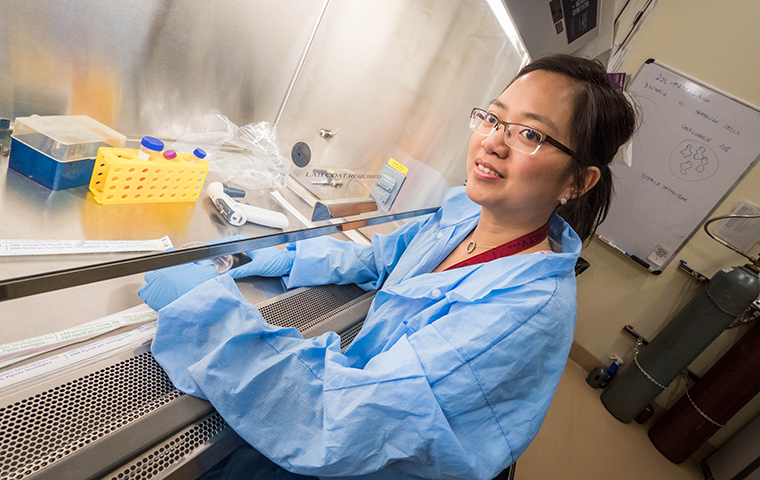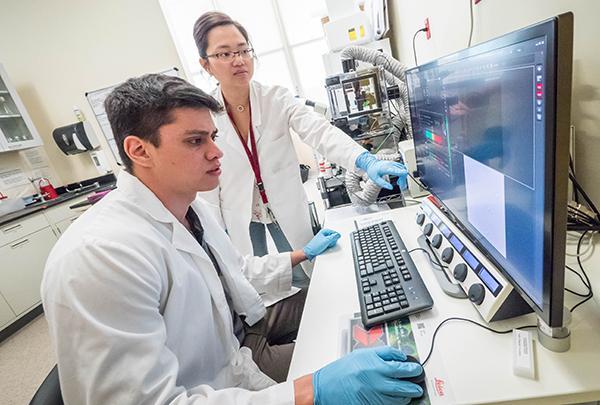
Let’s Make Better, Better
Daniel Levy M.S. ’18 and Mai Anh Do M.S. ’18 want to help bring gene therapy to the masses using a new method to deliver cancer-fighting DNA.
Using gene therapy to fight cancer isn’t a hypothetical in the United States anymore. The “first-gene therapy” created by Novartis is groundbreaking. It’s effective. And as of August 2017, it’s FDA approved.
“It also costs a half-million dollars,” Daniel Levy M.S. ’18 adds.
Levy is excited about the impact of chimeric antigen receptor (or CAR-T gene therapy) in treating cancers like leukemia but knows it’s not yet feasible for most patients. Currently, doctors have to remove T-cells from patients, cryogenically freeze them and transfer them to Novartis in New Jersey. Novartis then reprograms the T-cells to target and attack the cancers. The reprogrammed T-cells, called CAR-T, get transported to the patient and re-introduced back into their body to fight the cancer.
Not only is the process expensive, it’s time consuming.
“We want to skip all of that,” Mai Anh Do M.S. ’18 says. “We want to introduce exosomes with the CAR DNA, and then it’ll search for the T-cells itself.”
Levy and Do are part of a group of graduate researchers in Assistant Professor Bill Lu’s lab that wants to make the process of treating cancer through gene therapy even better. Instead of taking T-cells out and treating them, they want to reverse the process by sending exosomes—which are cell-derived sacs—in to deliver the DNA to the T-cells.
How do they do that? The key is targeting proteins. Do and Levy attach protein ligands to the outside of the exosomes which, due to their structure, can target the tissue of specific cells (like T-cells and cancer cells). Once the DNA-loaded exosome reaches the T-cell, the DNA is expressed which transforms the T-cell to a CAR-T cell which can fight the cancer.
What Can Exosomes Do for You?
Explaining this method has proved difficult, Levy says, even to colleagues at conferences. His solution is comparing the exosomes to UPS delivery trucks. In the trucks are packages with the modified, cancer-fighting DNA. Meanwhile, the targeting proteins function kind of like GPS, making sure the trucks end up in the right place.

Daniel Levy and Mai Anh Do work on a computer in the Bannan Engineering Labs
“The protein targets specific tissues or organs in your body,” Levy says. “So, it'll deliver the DNA only to the immune cells in the body.”
When the exosome finds the tissue it’s looking for, it latches on and delivers the DNA to the T-cell which fights the cancer, leaving healthy cells alone.
Unlike the CAR-T therapy at Novartis, this exosome delivery method was first hypothesized in 2011 and is still in its early testing. It isn’t approved for testing on humans or even animals.
In Lu’s lab, Do and Levy harvest exosomes and test the process in a culture dish, monitoring how the exosomes interact with diseased human cells—whether they go to the correct cells and how efficient they are once they get there. This could help scientists identify side effects and determine dosage down the road.
Levy and Do didn’t invent the exosome delivery approach, but their research—and the research of other scientists—can help make it a reality.
“The next step would be to perform animal studies on mice and later on humans,” Do says, explaining that testing would happen elsewhere.
If the process is deemed safe, it could have impact in more than just gene therapy and cancer treatment. Since exosomes are a means of delivery, it could be used to treat all sorts of illnesses.
“Let’s say you’re lactose intolerant,” Levy says. “You’re missing the lactase enzyme in your gut lining. If you had an exosome and put the lactase enzyme inside and then targeted to that area, then you could have lactose.”
Do and Levy will continue their research and hope to write a paper before graduating this spring. From there, Levy hopes to earn his Ph.D. and Do wants to find a job in a lab that works with exosomes.
Life in the Lab
Levy first became interested in bioengineering in high school when he saw someone using a prosthetic arm. The prosthetic was attached to the arm using electrodes so the person could manipulate it.
“Because our body just fires electrical signals, he could kind of control the robotic arm based on the electrical impulses,” Levy says. “I thought that was cool.”
Years later, he says his work in Lu’s lab has lived up to that standard of cool. He gets to work on a project that uses new technology to help people live better lives. Levy is an even-keeled guy, but this work gets him excited.
And the research has become more than just lab work. Levy and Do joined Lu’s lab last year as graduate students. Since then, they’ve spent a lot of time inside the lab located deep in the Bannan Engineering building. Plus, they’ve gotten to work closely with Lu. Not just in class or in the lab but even day-to-day, immersing themselves in the craft of research. More than the basics, they’ve peppered Lu with questions on the minutiae of research.
“What I love about Santa Clara is that I can work with Dr. Lu one-on-one every day,” Do says. “He comes to the lab. He talks with us. He goes to lunch with us. We hang out. We talk about research—and the research is cool. I think at a bigger university you don’t get that opportunity.”
Mai Anh Do M.S. ’18 wants to use exosomes with CAR DNA to simplify gene therapy treatments for cancer—which currently cost $425,000.